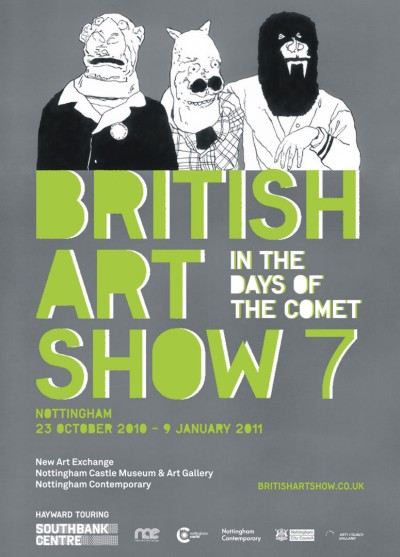|
BRITISH ART SHOW 7 “IN THE DAYS OF THE COMET”
At THE NOTTINGHAM CONTEMPORARY
The Nottingham Contemporary’s latest exhibition “In the Days
of the Comet” could be there most interesting yet in terms of the
variety and quality of the works on show; and in terms of the use of
space.
What has made this particular exhibition so interesting? As I have just
said, there is a great deal of variety to the works on show, but somehow
still a consistent feel- one which is nihilistic and faintly discomfiting,
from the minute the viewer steps into the gallery.
Upion entering “Gallery One,” the first thing that the viewer
sees is Brian Griffiths piece for the exhibition. His work is described
as “drawing on the melancholy humour of British sitcoms” and
this work in particular – a giant bears, stitched from a sagging
“half-defeated” head which fills up a deal of the room –
certainly has a melancholy effect. The guide says that “supported
by ropes it suggests a tent and a theatre backdrop, a place of refuge
and a moment of illusion.” For me, the disturbing childishness
of it evoked a huge-scale version of some of Paul McCarthy’s best
known works.
Throughout the exhibition, things remain consistent- there is a rhythm
between the works by artists Karla Black and Becky Bleasley, while the
works which are different in tone, such as paintings by Alisdair Gray
(better known as a novelist) sit easily by being dispersed in neat triptychs
throughout the exhibition.

My personal highlight, however, was a new piece by former Turner Prize
winner Wolfgang Tillmans. Filling the substantial room, his piece “Truth
Subtle Center” was gloriously free of subtlety, choosing to confront
the viewer with a series of realisms relating to both the world and
the media. Tillmans has kept scrapbooks of printed epherema since he
was a child and collects material on all subjects of current concern
to him, and uses the tables of the “truth study centre” as
a way of thinking about perception and truth. The vast tables hold a
range of thought provoking clippings worth spending time on, the interest
being largely in the dichotomys of the imagery, such as opposing press
opinions of the Israeli- Palestine conflict and a report on anorexia-related
deaths twinned with an advertisement promoting low-calorie virtue. This
is collage art on an enormous scale.
As enthusiastic as I clearly am about this, there were obviously some
pieces which I was unconvinced by. I am a big fan of video art and seeing
the screens in place filled me with an initial rush of enthusiasm. The
exhibition guide further stoked this enthusiasm with its information
that what I was about to view, Emily Wardill, responsible for the piece
“Gamekeepers Without Game” created pieces which “examine
the combined rhetoric and melodrama in media and politics. Her work
upsets the rhythm of traditional filmmaking through exaggerations or
strategic diversions in script, set and editing.” I did not get
this from “Gamekeepers without Game.” What I got from this
relocation of a 1635 Spanish play, “La Vida es Sueno”to contemporary
London, in which a father tries to reintegrate his daughter into the
family home after nine years in social care, was something beset by
hints of class snobbery and horribly clichéd characterisation,
trying desperately hard to be relevant but falling rapidly short of
the mark by several years. At 92 minutes it was also far to long for
an exhibition piece and rapidly became tedious. Nobody in the screening
room whilst I was there sat through the whole thing. A far better attempt
to connect to popular culture through video art was Haroon Mirza’s
brilliantly complex “Gaining a Degree of Control,” with its
use of previously unseen footage of Ian Curtis.
On the whole then, this is an excellent, (largely) consistent exhibiton
that shows the still young Nottingham Contemporary is set to grow and
grow. The exhibition is still on and runs until January 9th – it
comes highly recommended.
Amy Britton
|

